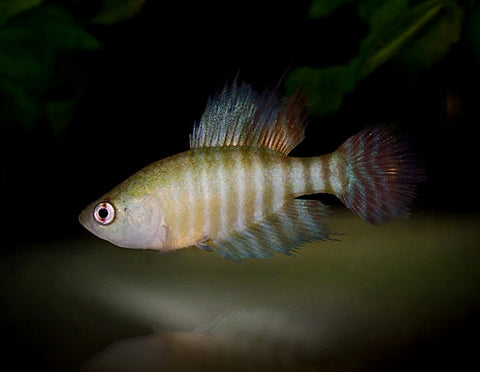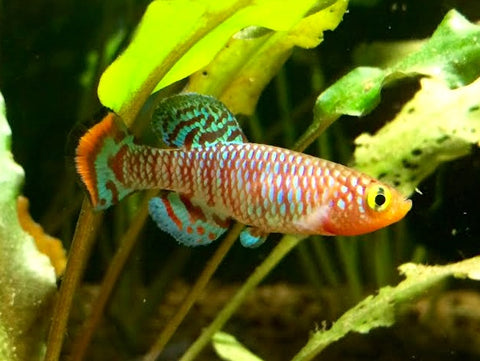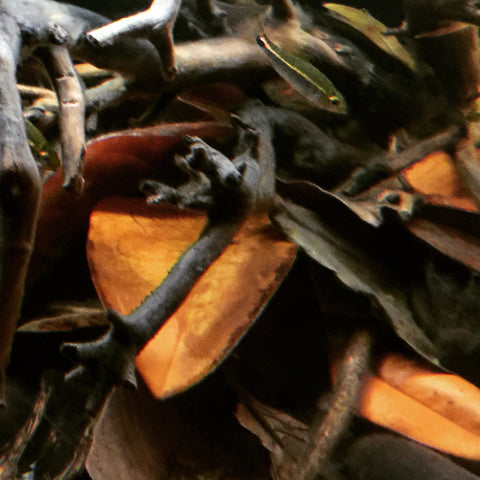- Continue Shopping
- Your Cart is Empty
Temporary fish-permanent displays...Another approach to enjoying South American annual killies
If you've ever kept killies- and a lot of you have- you're bound to realize that you've probably seen and maintained far more killifish from Africa than you ever have from South America. I found this a bit interesting, myself, because although Africa offers tons of cool killie species, South America has some pretty neat ones as well. Let's talk about them today.

At the risk of over simplifying it to the point where my killie-keeping friends will definitely smack me, you've essentially got two types- the Rivulus species which tend to be top-dwellers, living in streams and pools, and then you have the "annual" species, like Aphyolebias, Opthalmolebias, Gnatholebias, etc. And interestingly, we don't usually see many of these fishes in more "permanent" displays...or in display-type tanks at all, which is a bit of a shame, IMHO, because they are attractive and interesting fishes that deserve more attention.

Now granted, the "annual" species are just that- annual. You'd be hard-pressed to find a specimen pushing two years of age. Being "programmed" for a short life span based on reproduction and fast growth, they are not what you'd normally think of when planning a display, right?
Ahh- right up my contrarian alley! Now, I know I'm not the only person that has ever thought of this idea; it's been done before, so don't get your panties all up in a bunch. Nonetheless, like leaf litter tanks, no one else seems to be talking much about them, so it might as well be me who puts his head on the proverbial chopping block. Besides, I know at least a few of you who are wacky enough to take this not-so-new-yet-oddly-seldom-talked-about idea and run with it!

So, why not take this kind of approach? Keep some of them in a permanent display, to live out their lives and reproduce in a small aquarium that mimics to some extent the natural bodies of water they are found in?
Easy concept., right? Yeah, actually. Right?
Aphyolebias, for example, tend to come from forest-area pools that are shallow, filled with leaves and other botanical debris (!), and are rather still. As the pools dry up, the fish spawn like mad, and the eggs will incubate in the substrate for up to 10 months! Usually, they're ready to hatch in 6 months, but still...it's a long haul with these guys!

So, yeah, the optimum "traditional" breeding setup for these fishes is the old standby of a bare tank filled with peat moss, in which breeders are placed for a designated period (lie 4-5 days or so), then the eggs are collected and packaged in the moist peat for the appropriate incubation period. Cool, efficient...but, well...cool and efficient. I think that to really appreciate these fishes, it would be far more interesting to keep at least a few of 'em in a more permanent situation.
How about setting up a 5-20 gallon aquarium, preferably with a shallow footprint, a few delicate-looking branches (like "Spiderwood" or Manzanita), and lots of leaves on the bottom, over a soft substrate, like the coco-fiber-based "Fundo Tropical", which, although far more course than peat moss, would be a kind of cool substrate that the fishes could dive into to lay eggs. You could even rotate through several pairs in the display over the course of several weeks or more. I'll admit- harvesting the eggs out of a mass of leaf litter and "Fundo Tropical" would be a bitch...

However, you could simply do this: When you feel it's appropriate, just remove the fish, siphon out the water, and remove the substrate...or not. You can just cover it with some plastic wrap to keep things more or less moist.
You remember the old classic killie-keeper instructions to keep peat moss with eggs "like the consistency of fresh pipe tobacco (as if I'd know what that feels like...)." Instead of bagging it, you could be totally ridiculously contrarian and have an empty tank on your shelf with a layer of moist leaves and substrate material for 6-10 months. Then, you'd fill it up again and see what comes up..literally.

You're crazy. But super cool.
Efficient? No. Precise. Absolutely not. Cool? Hell, yes.
Of course, you could always let the substrate dry out to the appropriate consistency and just "bag it" as has been done for decades. Not everyone appreciates an empty tank with a pile of mushy damp leaves and such on the bottom. I was gonna get really stupid and suggest turning it into a vivarium-type thingy for a few months, with plants and frogs and such, before flooding your little rainforest once again...Perhaps fraught with challenges..but an interesting idea, huh?

So you can have your cake and eat it, too. You get to enjoy these magnificent, if not transient fishes for a while in a great-looking display that mimics to some extent the natural bodies of water that they are found in, and you can make a good effort to incubate some of their eggs.
Of course, you could do this with African killies, too. Duh.

Oh, and what of the Rivulus? You can and should keep them in permanent displays, too...They tend to jump from pool to pool as the water dries up...so maybe, you create a row of small tanks, one next to another, and slowly lower the water level in the preceding tank...?
Urrghh.

(Sumer Tiwari, I jacked your cool pic of R. rectocaudatus for this...)
Am I nuts? Yes. I freely admit that. But hey, you gotta think about crazy ideas, right? They just might yield a toned-down, halfway logical one now and again....
Until next time. Think differently. Stay on the "bleeding edge." Stay unique. Stay creative.
And Stay Wet (for at least half a year, anyways...)
Scott Fellman
Tannin Aquatics









Scott Fellman
Author